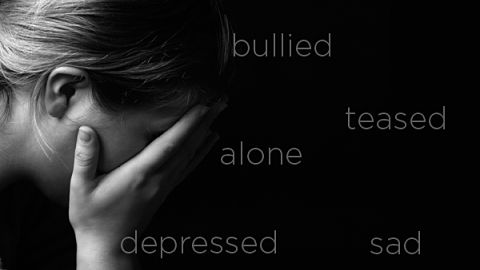The final barrier between the virtual world and the real world was erased last week when a 12-year-old girl, after being mercilessly harassed and bullied online, climbed a platform at an abandoned cement plant in Florida and jumped to her death. Cyber-world and tangible world are now distinctions without a difference.
 Nothing exemplifies the underlying toxicity, lifelessness and malice in this culture more than this tragic incident. It was reported on the national news without comment or feeling. Americans have come to expect such wickedness and have adapted to it. People can adapt to anything.
Nothing exemplifies the underlying toxicity, lifelessness and malice in this culture more than this tragic incident. It was reported on the national news without comment or feeling. Americans have come to expect such wickedness and have adapted to it. People can adapt to anything.
”I’m dead. I’m jumping. I can’t take it anymore,” Rebecca Ann Sedwick texted a friend just before she jumped, after changing her handle on Kik Messenger to “That Dead Girl.”
“If you haven’t killed yourself yet, would you please just die?” That’s an example of the kind of evil messages she received over months from 7th –grade girls. “They got what they wanted,” said her mother through tears. Seventh grade girls!
School officials knew about the bullying, which had extended to the schoolyard and included pushing and hitting. But there’s so much of it now, and the division between real and virtual is such that they were incapable of meeting it.
Predictably, there’s talk about bringing criminal charges against the girls who harassed Becca to death. But their sentence has already been imposed—they’ll have to live with what they did for the rest of their lives. If you don’t feel sorrow and compassion about that as well as Becca’s suicide, then you’re part of the problem, not the solution.
This one girl’s suicide signifies so much more than one girl’s tragic end that it would be impossible to explain in a 500-page book, much less a 1000-word column. But pause for a minute from your busy life and reflect on the fact: A gang of 15 junior-high girls systematically and relentlessly prodded a beautiful girl, one of their own kind and class, to kill herself. What does that say about this culture, and about the neglect of the adults who are completely out of their depth in dealing with such evil?
Teenagers absorb and express the essence of a culture; they don’t live in a world unto themselves. In previous generations, revolt against the social order (or disorder) was the norm in young people, almost a rite of passage. In recent years however, teens have been adapting and amplifying the darkness that most adults refuse to face and meet.
Heaping injury upon injury, such evil is either exploited for entertainment purposes, or sentimentalized. Both trends make its perpetrators in the adult world complicit in the slaughter of innocents, and innocence.
The site of Becca’s death has already has already become a memorial, with teddy bears, candles and balloons. Sentimentality is to genuine feeling as plastic fruit is to real apples. It allows ‘Breaking Bad’ to be glorified, given a wink and nod, rather than the opprobrium that previous generations and intact societies gave it.
a wink and nod, rather than the opprobrium that previous generations and intact societies gave it.
The problem is not ‘cyberbullying,’ nor even teenagers’ “online social lives.” ‘Cyberbullying’ is a catchall term that allows adults to distance themselves from the overriding underbelly of social relations in this country, which cellphones and social media merely exacerbate, through psychological and emotional distancing.
There’s a general perception, by both teens and most adults, that online communications aren’t real, and that anything goes, or at least that the normal limits on behavior don’t apply. For example, ever since the Net became a feature of everyday life, people have been having ‘virtual affairs’ that they believe won’t affect their flesh and blood marriages.
The root meaning of the word ‘cyber’ is instructive. It doesn’t mean less real than tangible reality, but just the opposite. ‘Cyber’ comes from the Greek ‘kybernetes,’ which means ‘steersman’ or ‘governor.’ That fits, since the online reality has come to govern the tangible world, and for many people, including vulnerable teens, it is dominating and steering it into darker and darker realms.
“It’s a whole new culture, and the thing is that as adults, we don’t know anything about it because it’s changing every single day,” said Denise Marzullo, the chief executive of Mental Health America of Northeast Florida, who works with the schools on bullying issues.
No, it’s the same old culture, just on steroids, with outmoded ideas like this governing the minds of parents, teachers and professionals charged with dealing with darkness where children are concerned.
Because bullying has shifted from Facebook and Twitter to Kik and Voxer does not mean that “it’s a whole new culture,’ just that the pathways of evil are changing much faster than its roots are being confronted. Yes, the so- called virtual world of social media has, like fungi growing in dark, dank caves, nurtured bullying, even in young girls. But that too is a symptom and not a cause.
called virtual world of social media has, like fungi growing in dark, dank caves, nurtured bullying, even in young girls. But that too is a symptom and not a cause.
The very notion “that it is increasingly difficult for parents to keep pace with their children’s complex digital lives” continues to differentiate a completely blurred line between the two supposedly distinct realities, online vs. real-world, making it impossible to deal with the overarching reality confronting everyone.
Both the ‘it’s-always-been-like-this’ school of thought on societal dysfunction and dystopia, and the ‘we-just-hear-more-about-it’ school completely miss the mark. The former is untrue, while the latter just means it’s affecting and infecting all of us more.
The truth, which the vast majority of Americans avoid like the plague (convincing themselves that there’s only ‘my truth’ and ‘your truth’) is that a pervasive darkness rules this land and saturates this culture. And since this culture is no longer limited to the geographical area of the North American culture hearth, but has become global, this phenomenon has enormous implications for human culture and consciousness as a whole.
Psychological/emotional distancing takes same form domestically as it does with foreign horrors like Syria—allowing childish adults to believe it’s ‘happening over there,’ not connected or related to me and mine.
But now, thanks largely to the World Wide Web, there’s no difference between inside and outside, between domestic and foreign, between terrorists and mass shooters, between jaded adults and jaded children.
Ironically, just before the news of this Florida girl’s suicide last week, the New York Times did an excellent, if also obtuse piece entitled, “Can Emotional Intelligence Be Taught?”
The phrase, ‘to children’ was left unsaid, though that was the focus of the article. But the question really is: Can adults learn emotional intelligence?
Martin LeFevre

